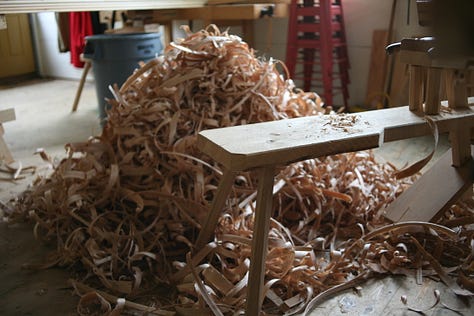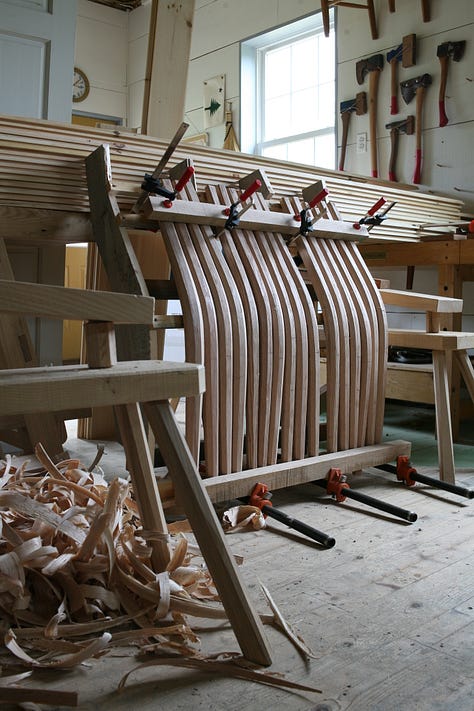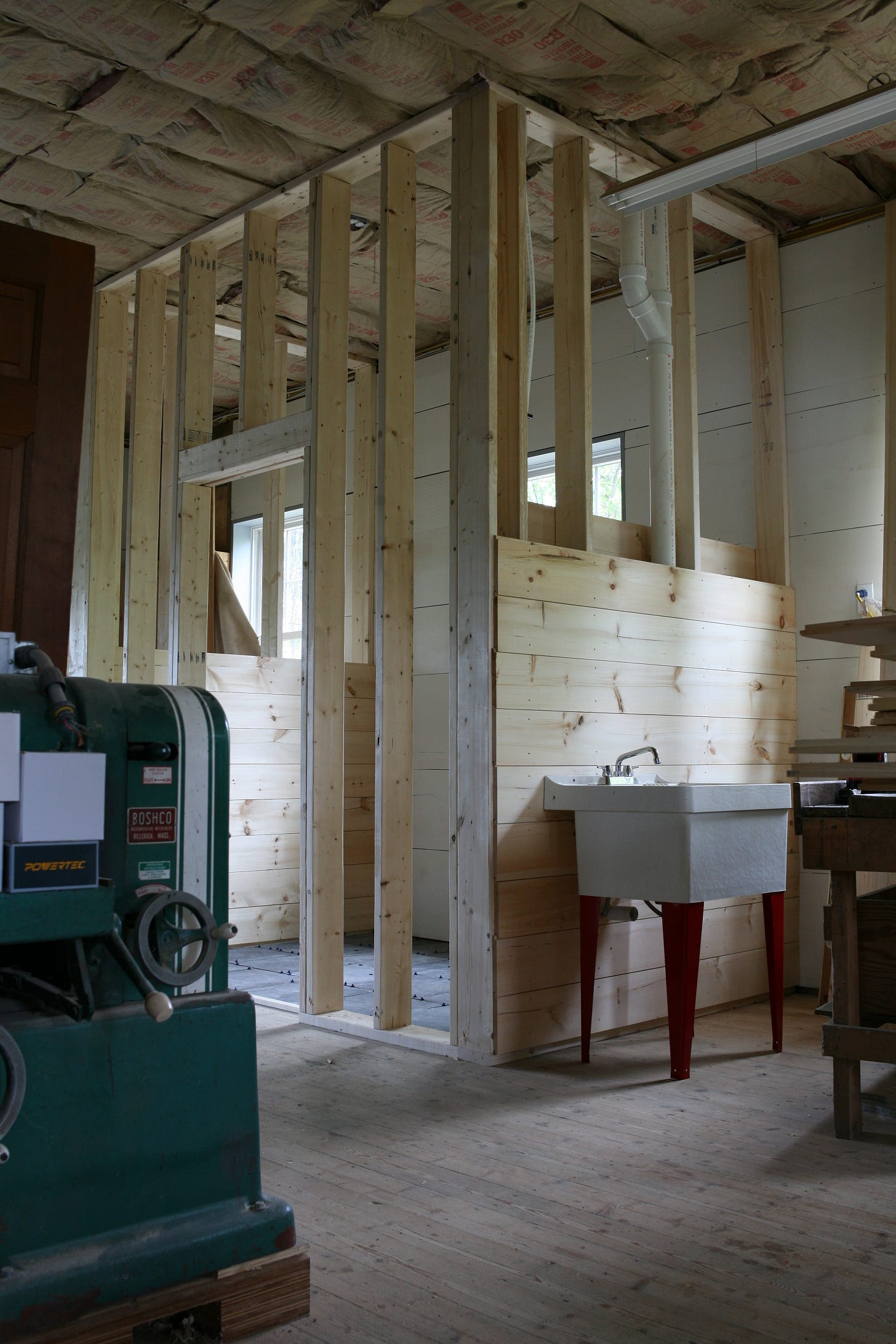For the past few years, I’ve slowly attempted to create “seasons” of work. The long winter for commissions, writing, and new ideas. Which reserves the spring and summer for workshop season. Of course there is overlap. I build year round…often to catch up on late work instead of taking on new. This allows a focus for all parts of the year. And I need a focus…otherwise the three (making, teaching, & writing) compete for daily time and inevitably all three fall behind schedule. Seasons allow space for intense focus, and the others time for rest.
Teaching season is nearly here. A group of excited and creative woodworkers sharing a shop is the recipe for a good time. And we’ll start next weekend in Berea, Kentucky, with a hickory bark harvesting class at Pine Croft. It’s the ideal way to start the season…a communal class where we walk into the woods with a forester to discuss healthy forest use, then work together to strip the bark off hickory logs. Here’s hoping for blue skies and a slight breeze.
I’m preparing within my shop as well. We now have water and plumbing, and the washroom is nearing completion. The plumbers worked their magic. Now I need to complete the carpentry piece. [It’s tough taking good photos in the shop at the moment…the floor is littered with piles of red oak shavings alongside the bathroom tile offcuts. It’s chaos. Also, unbeknownst to me, tiling is fun. I wish I knew that earlier. I mean, it’s not fun on the knees, but I’m already thinking of more tiling projects].
For the past month, I’ve spent a couple hours each day prepping for the upcoming chair class in Berea. It’s a lot of work. Greenwood classes can be grueling without some level of preparation. Students still do all aspects of the build without the driving pressure to get all the parts shaved and bent and drying in the first day or two. I’ve run classes that way before…and we’re all toasted by Day 3. I’d prefer not to run woodworking boot camps. So I prep and bend parts, and they can dry a few weeks before we make chairs out of them. Then students replace these parts with the parts they make.
Sometimes my mind wanders to whether I can mechanize aspects of parts making. Then I remember that I’m excited to get onto the shave horse each morning. It’s a perk of the work. I’d rather not lose the horse to increased efficiency. There’s a balance here…it’s something I think about as I work. The balance as it affects the strain on my body and as it affects the quality of each piece of oak as I shape the wood. I continue to shave the posts and rungs (and the band saw and planer help me with slat making).



There’s an old, cynical saying ending in “….and those who can’t, teach.” I’m the son of two high school vocational teachers, so that one never resonated. The preparation and energy that goes into good education is often unnoticed.
And here’s the thing about teaching woodworking. It’s a highwire act. Especially chairmaking (work four days, then assemble on the final day…except when something goes sideways). It’s also one of the things I love about teaching. Sharpness, knowledge, and attentiveness are needed. We don’t use many fixtures in my classes. There’s freehand drilling and freehand shaping and freehand assembly. This means things can (and sometimes do) go wrong. A rung mortise is drilled at the incorrect angle or someone tries to assemble the chair with the front posts pointing towards the floor and the back posts pointing upwards (that was a new one).
My head is on a swivel for a full week. I’m building each chair, mentally, alongside the student. I’d like to catch a potential issue before it becomes one.
Which means the instruction needs to be on point. Now’s the time of year to make the final adjustments. And to get used to talking to humans again (I usually lose my voice during the first class of the season).
Chairmaking starts in a week. I’m already a good nervous.
One note about the next book (tentatively titled, “Furniture Business”). I’ve interviewed about a quarter of the makers that I intend to profile for it. What I’ve found is that my upfront “pitch” to prospective persons or businesses does a decent job of conveying my intentions for the book. I’d like to hear about how the business works. I’d love to see behind the woodworking curtain. How do you do this? How do you make a living?
And that “pitch” seems right because people are either replused or they are excited to contribute. And those who have been open to sharing about their business practices and experiences are free and open with their thoughts. There’s been no holding back. Which should make for a great read (…I don’t yet venture a guess on when it’ll be completed).
One piece of the project has vexed me. The photography. I love photography and would, ideally, travel to each maker to photograph them in their space. But that’s not possible here. I can’t travel to 25-30 locations, as much as I’d like to do so.
So the issue turned towards making a coherent feel throughout the book. Lost Art Press helped brainstorm ideas. After batting around a few, a disposable camera became a leading contender. I’ll send out 35 mm Kodak film cameras. Or, if the maker enjoys photography and has a camera, ask them to shoot on their 35mm lens.
I picked up an inexpensive 35mm lens this past week (to better match the image quality of the disposable camera). My Canon 5D was designed with film quality as the target, so I’ll be able to use it on all of my site visits. And I’ll also shoot with the disposable. [The images within this post were shot with the new lens. First impressions: get close to the subject, much closer than I’m used to. And put the subject in the center. There’s more distortion around the edges of the frame than my familiar 50mm lens provides].
The images for the book are complimentary, not central. The writing is business and livelihood focused. I’m thinking that the book will be black and white. And it’ll likely be smaller size physically, so the images will be smaller.
The 35mm lens and disposable camer should provide the cohesive feel I’m working towards.





You could find a better 35mm lens with less distortion. You’d pay more. It would probably show up the disposables to their detriment. And frankly the results you showed here are very good anyways. So no worries :) Carry on & best luck for the season !
Looking forward to the new book.